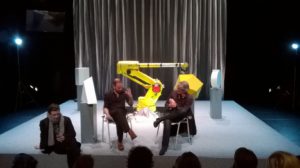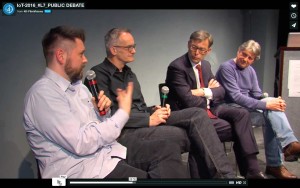a lecture by invitation of BNI on April 13th. 2017 at Intersteel Rhenen about the impact of IoT on interior-architecture and design; resulting in a fine discussion about the role/position of the architect and the consequences of technology within the home-environment.
Categorie archieven: projects
Prometheus and IoT
Tussen 2014 en 2016 bracht Theatercollectief Urland 3 voorstellingen rond technologie en maatschappij. “De Internet Trilogie is een collectieve, digitale trip waarin het lichaam transformeert en de toekomst voelbaar wordt gemaakt. De rite schrijft de mythe, natuurlijk op het analoge toneel.” Na afloop van de voorstelling op 4 november 2016 in de Schouwburg Rotterdam werd een boeiende inhoudelijke discussie gevoerd tussen regisseur Florian Hellwig, Martin Pot en publiek.

Booosting lecture on IoT & the Built Environment
a lecture at Blue City Rotterdam by invitation on April 28th. 2016 for Booosting, the Platform for Building Innovation, on the Internet of Things & Built Environment at Blue City in Rotterdam. Together with Floris Schiferli (Superuse) and Jeffrey Braun (afd. Buitengewone Zaken) and a group of architects we discussed the role and impact of the IoT within the built environment.
internet of things on ethics & privacy

Last Saturday, on WW-IoT-day April 9 we experienced a most inspiring and thoughtful event at V2 with the participation of 5 fine speakers: Rob van Kranenburg about the balance between objects and processes, Linda Kool about Intimate technology and the recent privacy report, Ben van Lier about the 4th.Industrial Revolution, Justin McKeown about the need for human initiative and values, Gerd Kortuem about data-literacy; all building on Jurgen Wege’s notes at the beginning and moderated by Leon van Geest. A debate on the autonomy of objects, the importance of human values, the need for an ethical discussion as well as data-literacy.
look and listen back…………
IoT & Built Environment 2015
On April 9th. 2015, the 4th. IoT, Built Environment & Smart City conference, now organized as a MeetUp, was held in Rotterdam, this year back on its original location, i.e. V2, Institute for the Unstable Media. Besides a fine line-up of speakers, among which Nimish Biloria (TUD-Hyperbody, Ben van Lier (Centric), Jan Belon (Buitengewone Zaken) , Floris Schiferli (Superuse), also one political party from Rotterdam (Nils Berndsen/D66) was present; which can only be admired, given the subject. Worthwhile in particular was the lecture (read by me due to her illness) from Cristina Ampatzidou; and especially the closing debate, moderated – like the whole event by Leon van Geest – delivered some interesting discussions and statements.
internet of things & philosophy
Next to many technologically focused and/or business-case driven meetings there was this much needed recent conference in York: IoT-Philosophy, from 3rd.-5th. of July 2014. Initiated/organised by Rob van Kranenburg (Sociotal), Justin McKeown (Univ.York St.John) and Joachim Walewski. It provided the framework for a thorough thinking: from the website’s homepage: “do we want to simply leave market forces to shape our reality? Or is there a deeper need, given the significance of this technology, to consider its ramifications within a philosophical context?”.
Conference IoT, Build Environment & Smart Cities
Last April 9th. 2014 on WW-IoT-day, the 3rd. IoT & Build Environment Conference was held; once again in Rotterdam, this time at ‘the Gouvernestraat’.
This location, with its history of over a hundred years of music, dance, theatre, poetry and meetings provided an excellent venue in the city-centre for both conference and parallel Hackaton, organised by Hogeschool Rotterdam, section Media & Communication. Additional theme for 2014 was Smart Cities; with some fine presentations/lectures which illustrated the sometimes contemporary values of earlier projects and visions. Lees verder
conference ‘iot & build environment’
2013*
On April 9, WW-IOT.day the second conference took place in Rotterdam at WORM as part of the IoT-days in cooperation with HRO and organised with HRO’s Peter van Waart. See for full program, presentations/streams and images the website. Lees verder
appartement Amsterdam
2009/2012
ontwerpfase
bestaande situatie
Het betreft een appartment voor 2 personen op de derde verdieping in een groene buitenwijk van Amsterdam. De huidige indeling levert een aantal, deels kleine, ruimtes op in een onderling onpraktische relatie:
het centraal gelegen toilet, grenzend aan de woonruimte, zorgt voor geluidsoverlast; de relatief grote gang neemt naar verhouding veel woonruimte weg, de keuken is een te smalle ruimte naast een slaapkamer.
Onderzocht wordt de mogelijkheid meer ruimte te creëren in een andere onderlinge relatie. Lees verder
conference ‘dwelling vs. the internet of things’
2011*
Dec. 9th. 2011; a conference organised with Council and hybridLiving at V2 on the subject of Home-Sense. A full day of presentations and lectures on the questions, consequenses and possible answers regarding the relation home – technology; in particular the Internet of Things. Speakers: Rob van Kranenburg (Council), John Post (IBM), Ben van Lier (Centric), Tomasz Jaskiewicz (ONL/TUD) , Tijmen Wisman (VU) , Eric Simon Thomas (Icrest). Students from WdKA Rotterdam, section Crosslab and Interior Architecture participated.
(see also the article by Edwin Gardner, published Jan 16th. 2012 on Archined, so far only in Dutch) Lees verder
